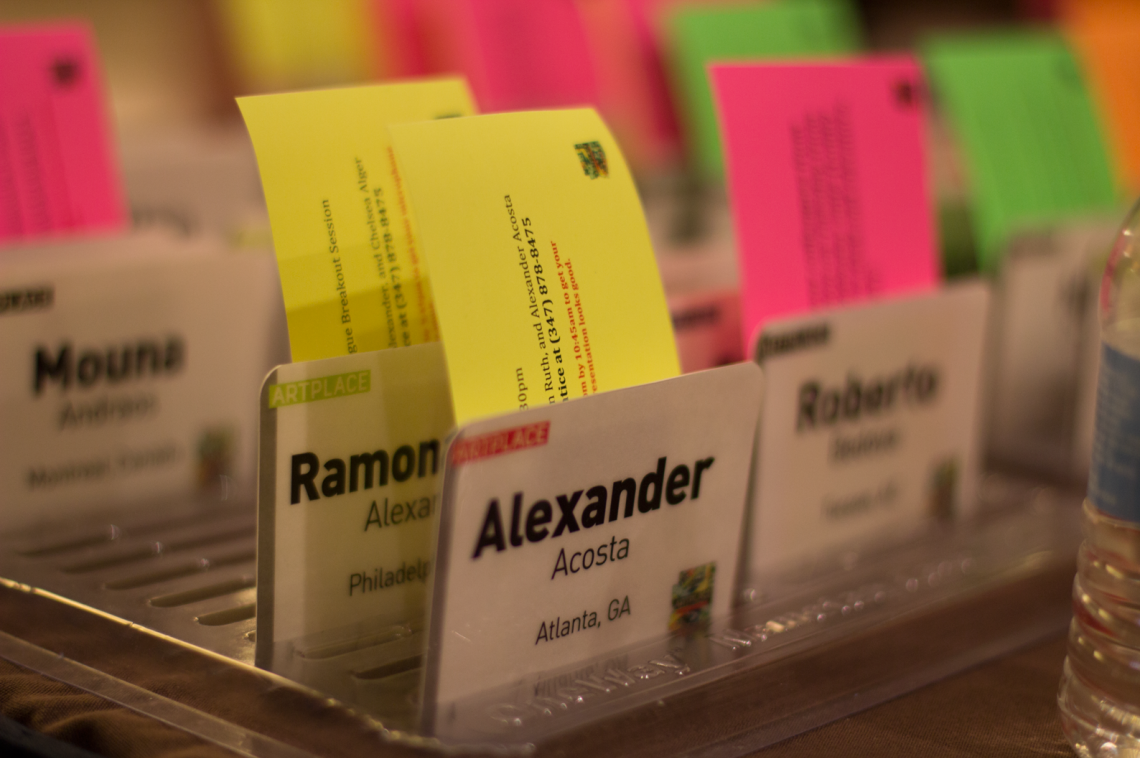
This year's ArtPlace Summit was a whirlwind of excitement, energetic conversations, inspiring presentations, and new friendships. Have you had a chance to catch your breath yet?
For those of you who weren't able to join us this year, we thought we'd put together an overview of our time together in Phoenix. If you were able to be there, well, it's never too soon to reminisce on time well spent.
This year's summit began and concluded in the Grand Ballroom of Phoenix's downtown Renaissance hotel, where representatives from funded projects and ArtPlace partners led plenary sessions on topics like "Expanded Approaches to Community Development" and "Creative Placemaking: When Artists are at the Planning Table". These sessions–which included both funded projects, members of the American Planning Association, and respected leaders in the creative placemaking field speaking about their work–set the tone for the summit and helped spur discussions on everything from the role of artists as problem-solvers to the difficult relationship many communities have with law enforcement.
Filled with passionate individuals who had remarkable stories to share, the plenary sessions all concluded with lively Q&A sessions which really seemed to help bring the room of 300+ attendees closer together.
Bryan C. Lee, Jr., director of place and civic design for the arts council of New Orleans and leader of the Youth Solutions initiative, spoke at the first plenary ("Expanded Approaches to Community Development") about strategies for using architecture and design to give agency to underserved youth. But as fruitful as the discussion was, it was what happened after the panel ended that seemed to make an even bigger impression.
"[After the panel] I got [to have] a lot of extra conversations. It was really nice, to carry on that conversation afterward and to get into the fine grain of how the work that we're doing can relate to others," Bryan told us.
For a lot of the attendees we spoke with, the immediacy of being in the room with other ArtPlace funded projects afforded them a unique opportunity: a place and a time to think deeply about creative placemaking, to receive validation from others who understand the goals they're looking to achieve, and the chance to learn from the challenges, triumphs and missteps of fellow attendees.
The breakout sessions on the second day of the summit seemed to really spark these conversations in earnest.
Breakouts were offered on everything from how artists can develop new methods for creatively documenting community engagement initiatives, to the power of music as a creative placemaking tool, to the role of theater in effecting public policy. Most attendees took the opportunity to move outside their comfort zones, stepping into breakouts that were unrelated to their typical fields to scavenge for new ideas, strategies, questions and inspiration.
Don't worry–even if you weren't in attendance, we'll be sharing the wealth of knowledge that came out of the breakout sessions in future blog posts! We're sorry to report, however, that we won't be able to recreate the incredible experience that was the 2nd day Roosevelt Row walking tour via the blog. (You can still check out #ArtPlaceSummit and #WalkRoRo on Instagram and Twitter for the virtual experience.)
During the first day's Welcome Session, Phoenix's Mayor Stanton said, "If the heart of Phoenix is ASU, the soul of Phoenix is Roosevelt Row." The walking tour gave attendees the opportunity to witness the downtown art community in flux as it undergoes new development and copes with the loss of pre-existing community arts spaces and impending gentrification.
Naturally, many of our attendees weren't strangers to the kind of planning issues the development presented, but with members of every creative placemaking facet present (urban planners, artists, administrators, representatives of community-based orgs, etc), the tour was a chance to think through ArtPlace's four creative placemaking questions as a group in realtime.
And, of course, the experience seemed to strengthen our relationships with one another.
As we shared meals, morning yoga, copious amounts of coffee, and an incredible party at the beautiful Mesa Arts Center, we grew comfortable enough to challenge each other, and to respond without feeling that we're supposed to have all the answers.
"I think the majority of people that I've met in my lifetime come to see the world as a fixed place and they just deal with it the best way they can," Jorge Ferreira, a rapper, artist and Deputy Sheriff with the Alameda County Sheriff's Office, said when we asked what he took away from the summit. "It's comforting to be in a group of people who believe they can positively impact the world."
For most, it seems that the biggest takeaway from this year’s summit didn’t come in the form of one-size-fits-all strategies or one-dimensional networking–it came in the form of camaraderie, reassurance, and hope.
In the coming weeks, we’ll be sharing more focused insights into what came out of this year’s breakout sessions, what individual attendees experienced, a guest blog post from our friends at Rural Arts Weekly, a closer look at the role of the artist in community planning, and how the event’s general discussion was poised to tease out ArtPlace’s four creative placemaking questions.
So stay tuned for these insights into our time in Phoenix, but in case you can’t wait, HowlRound was kind enough to keep a record of all the livestreamed events for your viewing pleasure.





